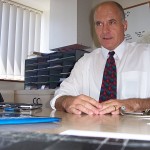Tales of a Medicine-Watcher are true stories from 50 years in medicine. Names and dates changed, staff names real (unless otherwise noted). The term Medicine-Watcher is used in The Youngest Science, the autobiography of Lewis Thomas, which I use with respect.
I didn’t know what to do, and stared at the phone. Freddie had seen me a week earlier, his first visit. He had a most unusual and distinctive surname. One I hadn’t come across for many years. In fact, not for 40 years. Before finishing the consultation, I asked. “Freddie, did you have an older relative called Dana?” “Yeh, Auntie Dana, she’s actually my great-aunt”. I paused, made a quick decision, and asked. “Um, I take it she’s still alive?” “Yep, amazing, after all she went through”.
It was a prized job for a second year resident doctor at St Vincent’s Hospital in Melbourne. Haematology. The boss was Prof David Penington, a superb clinician, and he had a great team. Most of the patients had haematological malignancies. It was my first day of a 13 week roster. One of the tasks of the resident was to dilute up and administer all the oncology drugs for that day. I had my first tray of rubidomycin, vincristine and a steroid. I checked the chart. Dana, bed 20, St Margaret’s.
She was a country girl in her 40s with acute myeloid leukaemia and had been in for some months. The survival figures in the early 70s were about 20%. “Hello Dana, I’m John, just started here today” “Hello John, I was just getting used to the previous resident” “Yeh, sorry, we move around” “You’ve got the poisons?” “Yep. Is this arm OK?” Back then there were no ports or PICC lines. I could see she didn’t have an intravenous line. “No, love, no veins there” I moved around to the other side. “Nope, don’t bother there, none left” I looked at her. “Hands?” “All gone. Just one vein left. Right foot”. This was not going well. “Um…OK”
So I administered the drugs though a dorsal vein on the top of her right foot over the next 13 weeks. She maintained her sense of humour, never flinched, gave me verbal support each time, chatted, we got on well. I never forgot her. She taught me a lot about clinical medicine, stuff that wasn’t in the textbooks.
“Could you ask Dana whether she minds if I call her. Tell her I was one of the residents that treated her 40 years ago”. He subsequently rang through her number.
I thought about it for a few minutes. Then rang her. She was in her eighties, sharp as, we chatted for 15 minutes. She lived a couple of hundred kilometres from Melbourne. It turned out that Dana was one of the few long term leukaemia survivors from that era that had been reported in a paper years later. I was able to thank her for teaching me so much about communication, about treating very ill people. I praised her stoicism. It was a good phone call.
When I hung up, all I could think about were those tragic news stories of earthquakes where hundreds die, but five days after the event they unearth one child, just one, but alive, and everyone cheers. I wanted to cheer.
“It is far more important to know what person the disease has than what disease the person has” William Osler

